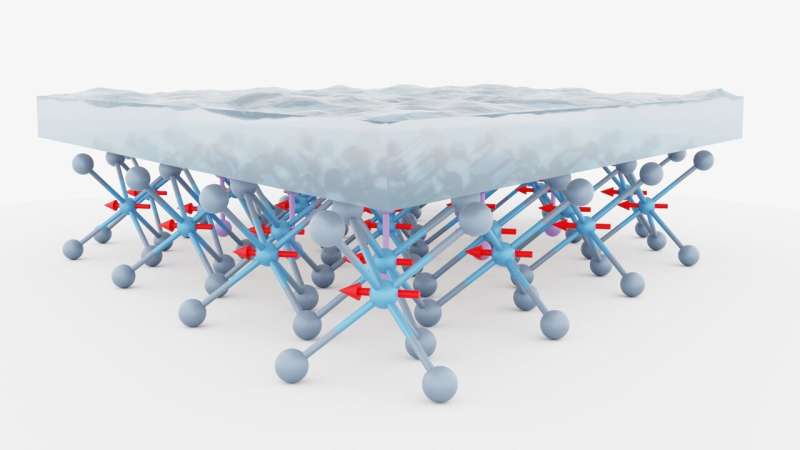Ball-and-stick model of the crystal structure of Cr2Ge2Te6 covered with the ion gel. The red arrows represent the magnetic moments of Cr atoms. Credit: Verzhbitskiy et al.
Electrical control of the magnetism of novel two-dimensional ferromagnetic semiconductors could enable the development of new types of spintronic devices—electronic devices that leverage the intrinsic magnetic properties of electrons to transmit, store and process information.
To be technologically viable, these devices should operate at or close to room temperature. However, most existing layered ferromagnetic semiconductors exhibit Curie temperatures below 100 K. Moreover, the interplay between magnetic order and electrical charges in these materials systems remains largely unexplored.
Researchers at the National University of Singapore, University College London (UCL) and University of Science and Technology in Beijing recently proposed a new method to modulate the magnetic anisotropy of chromium germanium telluride, Cr2Ge2Te6, a layered ferromagnetic semiconductor. The findings presented in their paper, which was published in Nature Electronics, could have important implications for the development of a wide range of hybrid electronic devices.
"The idea of electrically controlling magnetism in a magnetic semiconductor, which is key to developing energy-efficient information processing and storage devices, has been around for decades," Associate Professor Goki Eda, who led the team that carried out the experiments, told TechXplore. "However, the effect of electric fields on magnetism in most materials is too weak to be useful for real applications."
Recently, studies showed that some layered semiconductors exhibit remarkable magnetism even when thinned down to nanoscopic thicknesses. Due to the ultrathin body of the thinned materials, their physical properties are highly susceptible to gate electrostatics. Thus, electrical control of their magnetic properties by gate electrostatics has become easier, and promising results were reported by several research groups.
Inspired by these recent findings, Prof. Eda and his colleagues started testing methods that could enable the electrical control of magnetism in ultra-thin crystals of Cr2Ge2Te6. They soon realized that these materials' magnetism cannot be effectively tuned using the standard solid-gate oxides (i.e., dielectric layers typically used to modulate the electrical properties of semiconductor-based transistors).
The team decided to boost the electric field effect using an electric double-layer transistor geometry where gel-like electrolyte forms a layer of ions at the surface of the crystal, generating strong electric fields. This device geometry allowed them to achieve electron doping densities one order of magnitude higher than those typically achieved using common solid oxides. The researchers showed that using the electric double-layer transistor geometry, the Curie temperature and magnetic anisotropy of Cr2Ge2Te6 can be modulated via electrostatic gating.
"Due to this high electron density, the changes in the magnetic properties of the semiconductor became profound," Dr. Ivan Verzhbitskiy, a research fellow who carried out the experiments, explained. "The Curie temperature was enhanced by more than 140 degrees, from 61 K to 205 K. Such a pronounced electric field effect on Curie temperature has not been observed in other magnetic semiconductors. We were excited to observe such a dramatic increase in the Curie temperature of a magnetic semiconductor with electric fields, as it means that we can switch on and off the magnetism of a material, similar to the way in which a transistor switches electrical signals on and off."
The findings could have important implications for the fabrication of hybrid devices capable of both storing and processing information. In the future, the same strategy could be applied to other layered semiconductors to investigate the modulation of magnetic properties further.
"We plan to investigate the mechanisms behind the observed phenomenon in greater detail," Prof. Eda said. "With a better understanding of the phenomenon, we should be able to improve the operation temperature and eventually realize room-temperature tunable magnetism, which is crucial for practical applications."
More information: Ivan A. Verzhbitskiy et al. Controlling the magnetic anisotropy in Cr2Ge2Te6 by electrostatic gating, Nature Electronics (2020). DOI: 10.1038/s41928-020-0427-7
Journal information: Nature Electronics
© 2020 Science X Network
























